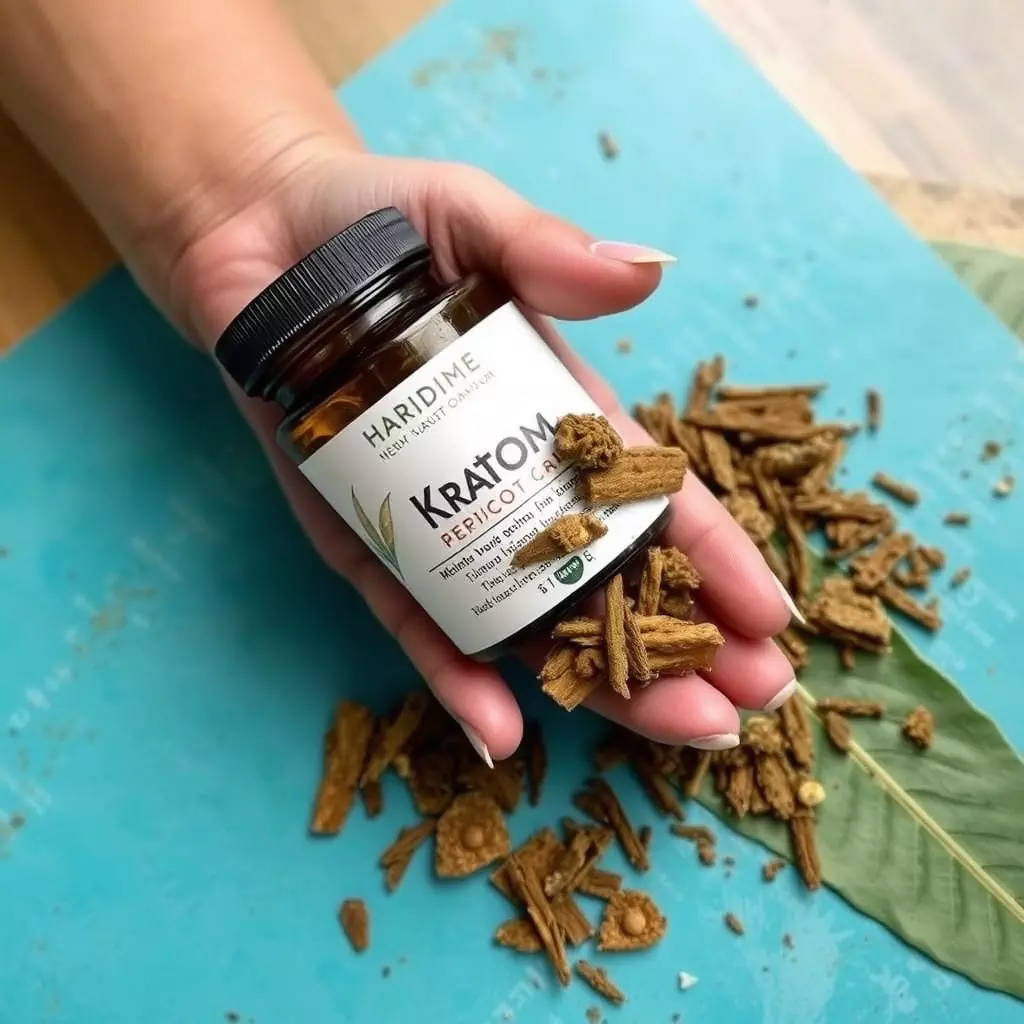Kratom, a natural substance derived from the Mitragyna speciosa tree, has shown potential for joint pain relief, particularly among individuals recovering from substance use disorders. Its active alkaloids, mitragynine and 7-hydroxymitragynine, interact with opioid receptors to provide analgesic effects, which can be beneficial for chronic joint conditions like osteoarthritis and rheumatoid arthritis. Kratom also influences neurotransmitters to possibly improve mood, reduce stress, and alleviate anxiety, supporting overall well-being in recovery. Its anti-inflammatory properties may further aid in pain relief by reducing inflammation. However, the FDA has issued safety warnings about kratom's risks, including potential addiction and withdrawal symptoms, highlighting the need for caution and responsible use. The legality of kratom varies by jurisdiction, so it's crucial to verify its status in your area before use. For those in recovery considering joint pain relief with kratom, it should be done under medical supervision, with careful consideration of dosage and sourcing from reliable vendors to ensure safety and efficacy. Clinical research continues to investigate the effectiveness and safety of kratom for joint pain management within this population.
exploration into the multifaceted role of Kratom as a therapeutic tool in addiction treatment and recovery unveils its potential benefits, particularly in alleviating joint pain relief for individuals transitioning from substance dependency to healthier living. This article delves into the scientifically grounded properties of Kratom, elucidates its impact on chronic discomfort, and addresses the complex legal environment surrounding its use. Navigating the nuances of Kratom’s efficacy and legality ensures a safe and informed approach to integrating this alternative remedy in one’s recovery journey.
- Unraveling the Potential of Kratom for Addiction Treatment and Recovery: A Closer Look at Its Therapeutic Properties
- Kratom's Role in Joint Pain Relief: An Alternative Approach to Managing Chronic Discomfort for Those in Recovery
- Navigating the Legal Landscape and Safe Practices of Using Kratom for Addiction and Pain Management
Unraveling the Potential of Kratom for Addiction Treatment and Recovery: A Closer Look at Its Therapeutic Properties

Kratom, a botanical derivative from the leaves of the Mitragyna speciosa tree, has garnered attention in the realm of addiction treatment and recovery due to its complex pharmacological profile. Its efficacy in providing joint pain relief is one of the therapeutic properties that have drawn considerable interest among those exploring alternative treatments for chronic pain. The alkaloids present in kratom, such as mitragynine and 7-hydroxymitragynine, are believed to interact with opioid receptors in the brain, offering analgesic effects that can be beneficial for individuals suffering from joint pain associated with conditions like osteoarthritis or rheumatoid arthritis. This pain relief capability is not only significant for managing physical discomfort but also plays a crucial role in addiction treatment as it may reduce withdrawal symptoms and cravings, which often accompany opioid cessation. As research continues to unfold, the potential of kratom in providing joint pain relief and facilitating detoxification processes suggests a promising avenue for those seeking recovery from substance use disorders.
The therapeutic properties of kratom extend beyond its analgesic effects, offering multifaceted benefits that may aid in addiction recovery. These benefits include mood enhancement, stress reduction, and a potential decrease in anxiety levels—all of which are critical factors in maintaining sobriety and overall well-being. Kratom’s influence on neurotransmitters such as dopamine and serotonin can help stabilize mood and provide a sense of calm, which is essential for individuals transitioning from addiction to a healthier lifestyle. Additionally, the anti-inflammatory properties of kratom may contribute to reducing the inflammation associated with joint pain, thereby improving physical comfort and mobility—factors that are often neglected in traditional recovery programs. As the scientific community investigates these therapeutic attributes further, the role of kratom in holistic addiction treatment and recovery is becoming increasingly clear, offering a natural alternative for those in need of relief from both chronic pain and substance dependency.
Kratom's Role in Joint Pain Relief: An Alternative Approach to Managing Chronic Discomfort for Those in Recovery

Kratom, a plant from Southeast Asia with leaves that contain compounds which can interact with opioid receptors in the brain, has garnered attention as a potential alternative for joint pain relief. For individuals in recovery from substance use disorders who often face chronic discomfort without the option of traditional opioids, kratom presents an intriguing non-addictive avenue for managing pain. The alkaloids found in kratom, such as mitragynine and 7-hydroxymitragynine, have been reported to provide relief from joint pain due to conditions like arthritis or injuries. Users typically consume kratom in the form of capsules, tea, or powder, and the effects can range from mild to significant pain reduction, depending on the dosage and strain.
It’s important to approach the use of kratom with caution, as it can interact with other substances and may have side effects. The FDA has issued warnings about the risks associated with kratom, including potential addiction and withdrawal symptoms. Therefore, those interested in using kratom for joint pain relief should consult healthcare professionals first. In recovery, managing pain without the risk of relapse is crucial, and kratom may offer a safe alternative when used responsibly and under medical supervision. Clinical studies are necessary to fully understand its efficacy and safety profile for joint pain relief in this context, but anecdotally, many recovering individuals have found it to be a beneficial component of their holistic treatment plan.
Navigating the Legal Landscape and Safe Practices of Using Kratom for Addiction and Pain Management

When exploring the potential benefits of kratom for addiction treatment and recovery, it’s crucial to first understand the legal status of this substance. Kratom, derived from the leaves of the Mitragyna speciosa tree, has garnered attention for its purported analgesic properties, particularly in addressing joint pain relief without the opioid-related side effects and risks. As of now, the legal landscape surrounding kratom is complex and varies by jurisdiction; while some regions have fully legalized it, others have imposed restrictions or scheduled it under their controlled substances acts. It’s imperative for individuals considering kratom as part of their pain management strategy to verify its legality in their area and stay informed about any changes in legislation that could affect access.
For those who reside in areas where kratom is legally available, safe practices are paramount. Users should approach kratom with caution, understanding that while it may offer relief from joint pain, its effects can be potent and unpredictable. It’s recommended to use kratom products from reputable sources to avoid contaminants or adulterants that could compromise health. Additionally, careful dosing is essential, as high doses can lead to adverse effects. Consultation with a healthcare provider before integrating kratom into any treatment plan is advised, especially for those recovering from addiction. This step ensures that the individual’s overall health and any potential interactions with other medications are considered, thus facilitating a safer and more effective approach to managing joint pain and promoting recovery.
Kratom’s potential as a multifaceted tool in addiction treatment and recovery, particularly in managing joint pain relief during this process, has been explored with promising insights. This article delved into the therapeutic properties of kratom, its role in providing alternative pain management for those recovering from substance use disorders, and the legal considerations necessary to navigate its use responsibly. While further research is warranted to fully understand its efficacy and implications, the evidence presented suggests that kratom could offer a valuable option for individuals seeking relief from chronic joint discomfort while pursuing addiction recovery. It is imperative for those interested in exploring kratom as part of their treatment plan to do so under professional guidance, within the framework of the law, and with awareness of the potential risks and benefits.






